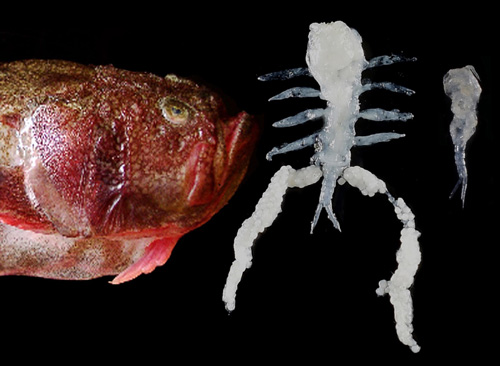Hiroshima University’s ambitious biodiversity study, focused on deep-sea crustaceans off the Indian Ocean, has led to a ground-breaking revelation, uncovering a previously unknown family and a new genus of parasitic crustaceans. This pioneering research marks a significant milestone in marine biology and symbiotic relationships in the world's oceans. Led by the accomplished Dr. Panakkool Thamban Aneesh, Assistant Professor, Hiroshima University, Japan, the dedicated research team has identified a new family of parasitic copepod, aptly named Uranoscopicolaidae, which was found to infest the Dollfus’ stargazer Uranoscopus guttatus dwelling in the deep waters off the southwest coast of India, at depths ranging from 300 to 550 meters. The findings of this trailblazing research have been documented in the latest edition of the esteemed Journal of Natural History by the authors Dr. Aneesh PT (Hiroshima University), A.K. Helna (Regional Forensic Science Laboratory, Kannur), BAV Maran (Nagasaki University, Japan), and A Biju Kumar (University of Kerala).
This ground-breaking discovery has resulted in the creation of a new genus and species, Hirodai ohtsukai, under the new family Uranoscopicolaidae family. The newly coined genus, 'Hirodai,' pays tribute to Hiroshima University, while the species is named 'ohtsukai' in honour of Dr. Susumu Ohtsuka, a distinguished copepodologist, ecologist, and marine biologist at the Graduate School of Integrated Sciences for Life, Hiroshima University, Japan. Dr. Aneesh PT, the driving force behind this significant exploration, expressed his enthusiasm for the implications of the findings, stating, "This discovery highlights the critical role of previously understudied deep-sea crustaceans in shaping marine biodiversity and ecological dynamics. The study of fish parasites also provides a deeper understanding of the ecosystem. For example, the new family of parasites were found only in the host fish collected off Colachel, Tamil Nadu and not from the Kerala coast, suggesting that environmental factors may have some influence in triggering the infestation. Further, these parasites also show a strict site-specificity, as each parasite species in the host Uranoscopus guttatus infests specific locations such as the buccal cavity, oral cavity and gills”. The deepsea biodiversity studies are challenging and interesting as they reveal a new world of associations in the unknown marine habitats and enrich our knowledge of the marine food web. A few more interesting and hitherto unknown crustaceans in the deepsea await publication, which shows the importance of deepsea biodiversity studies. We are excited about the potential implications of this research for our understanding of symbiotic relationships and the broader implications for marine conservation.
Order Cyclopoida Burmeister, 1834
Suborder Ergasilida Khodami et al., 2019
Family Uranoscopicolaidae Aneesh, Helna, Kumar & Maran, 2023
Genus: Hirodai Aneesh, Helna, Kumar & Maran, 2023
Hirodai ohtsukai Aneesh, Helna, Kumar & Maran, 2023

Hirodai ohtsukai in the new family and the host fish
About the study
Journal: Journal of Natural History
Title: Proposal of a new family for Hirodai ohtsukaigen. n. et sp. n. (Crustacea: Copepoda) infesting Uranoscopus guttatus Cuvier, 1829 (Perciformes: Uranoscopidae) from the south-west coast of India
Authors: Panakkool Thamban Aneesh, Ameri Kottarathil Helna, Appukuttannair Biju Kumar & Balu Alagar Venmathi Maran
doi.org/10.1080/00222933.2023.2259556

 Home
Home







